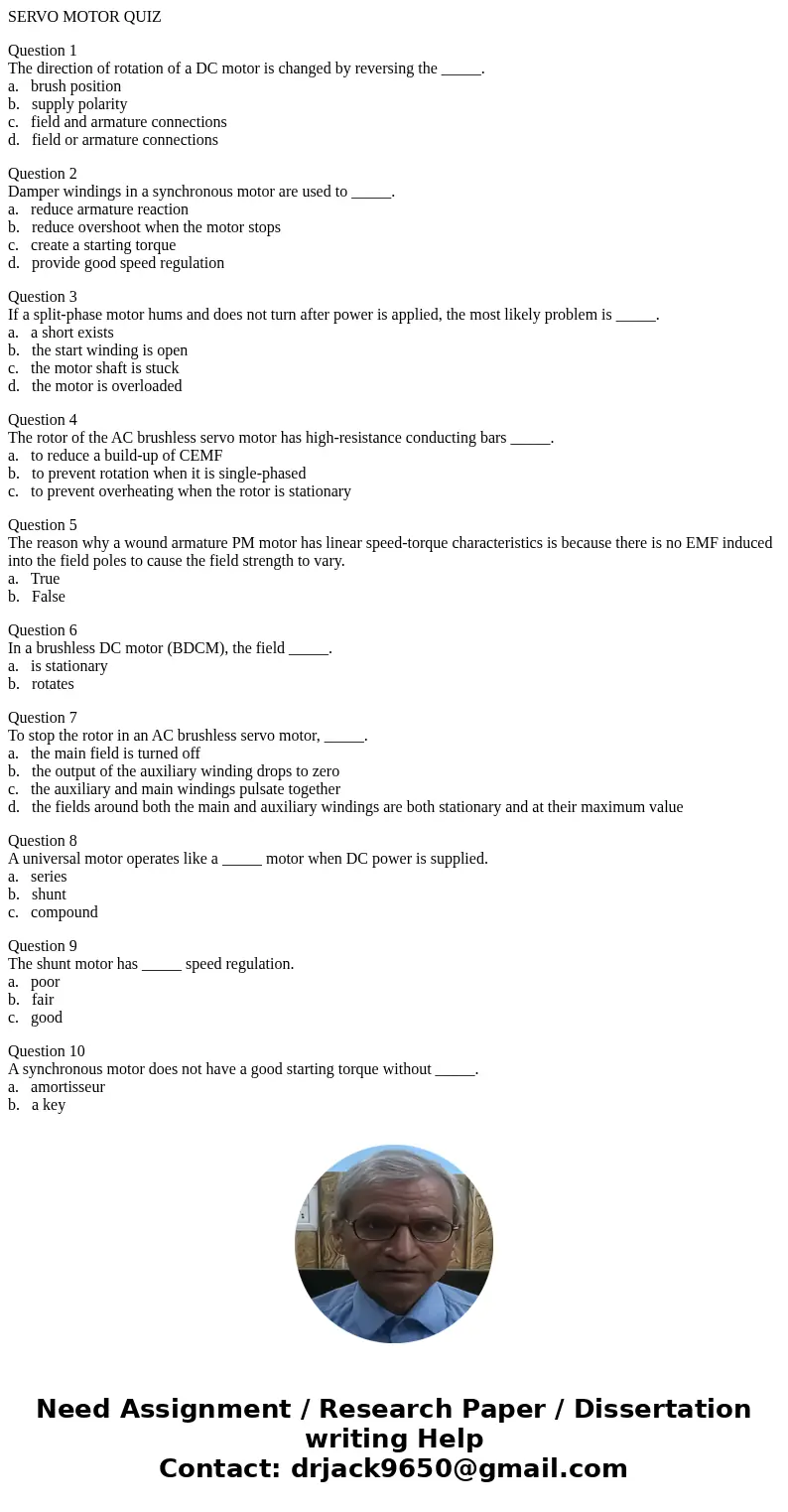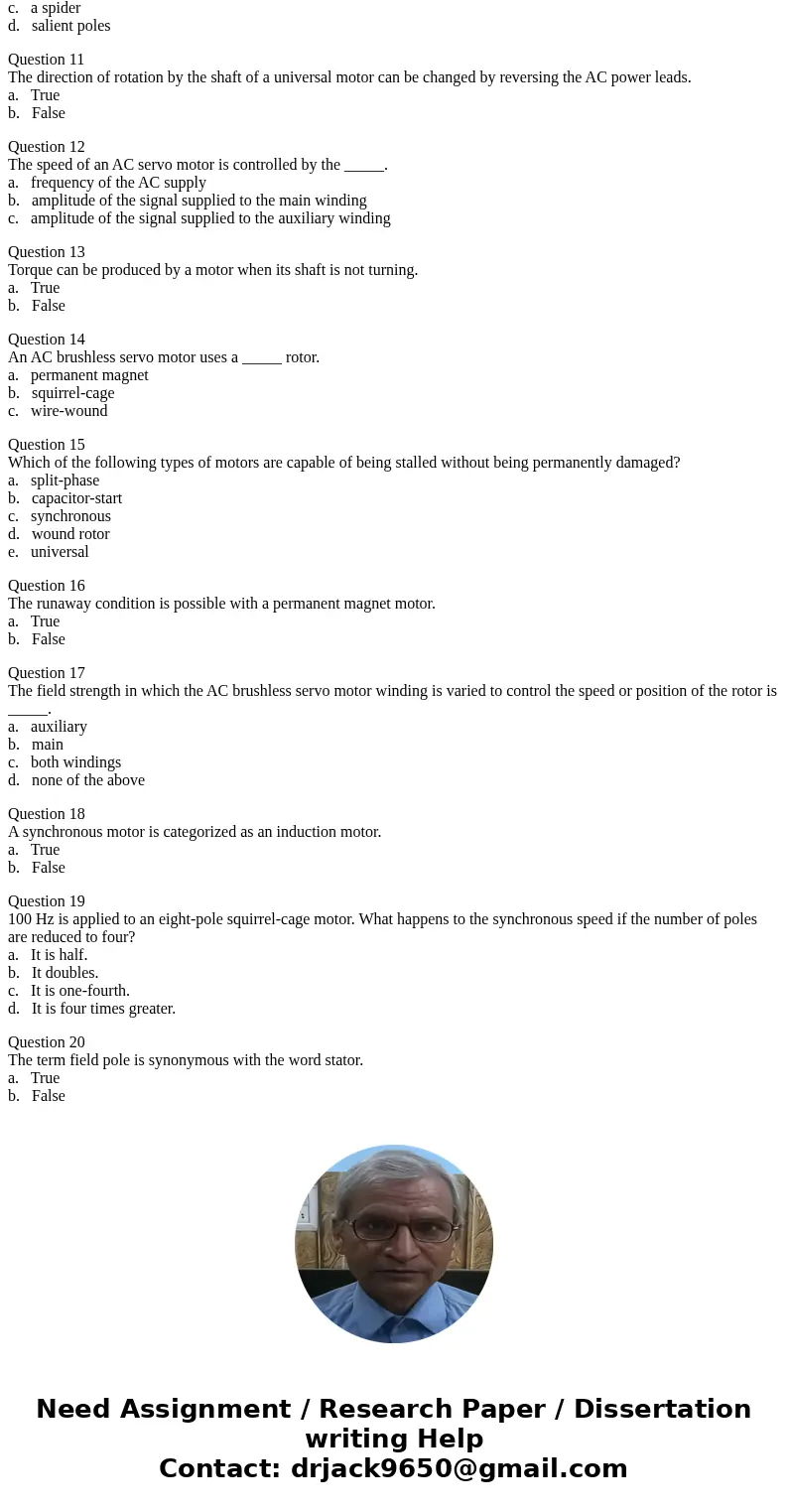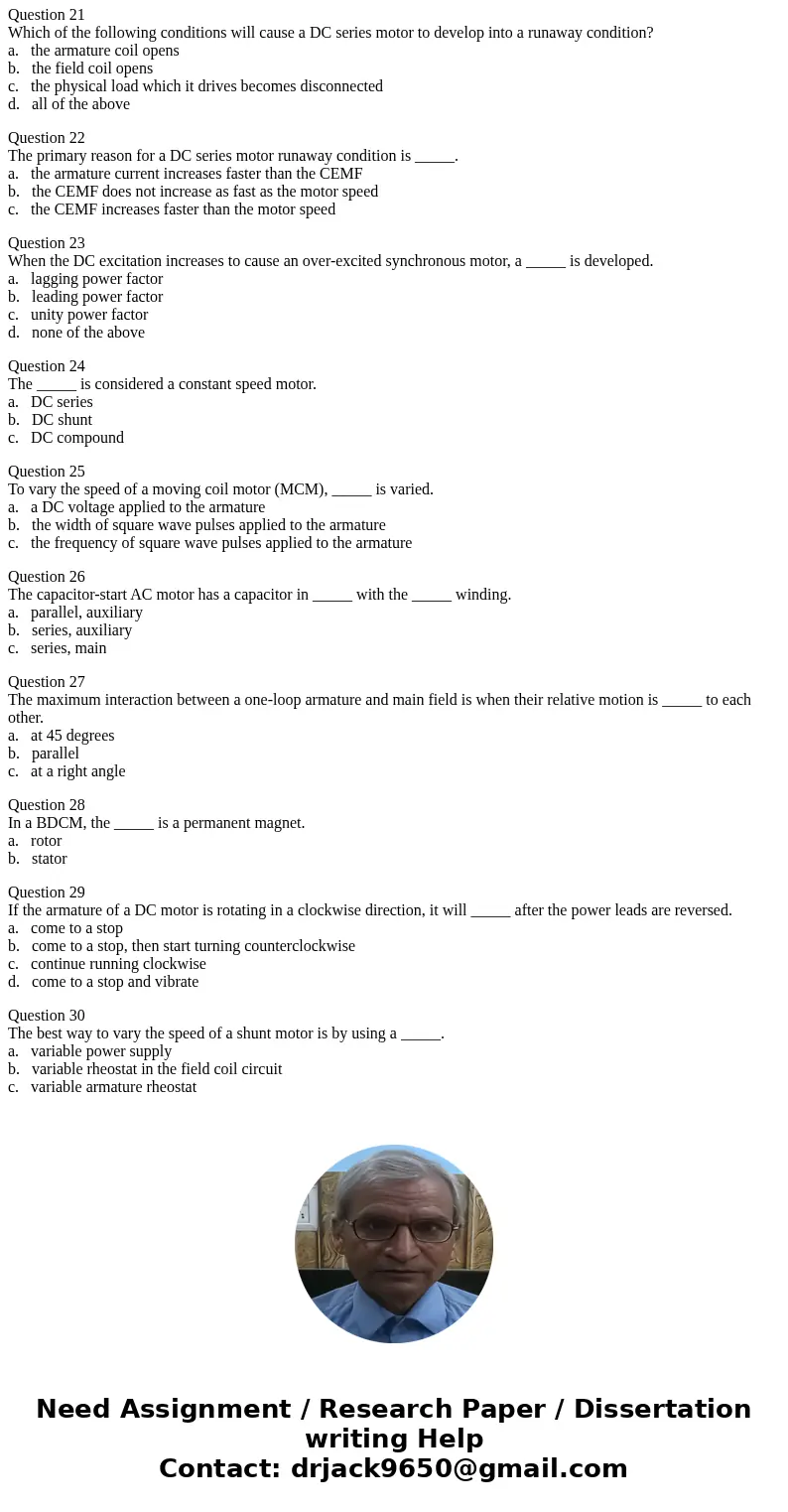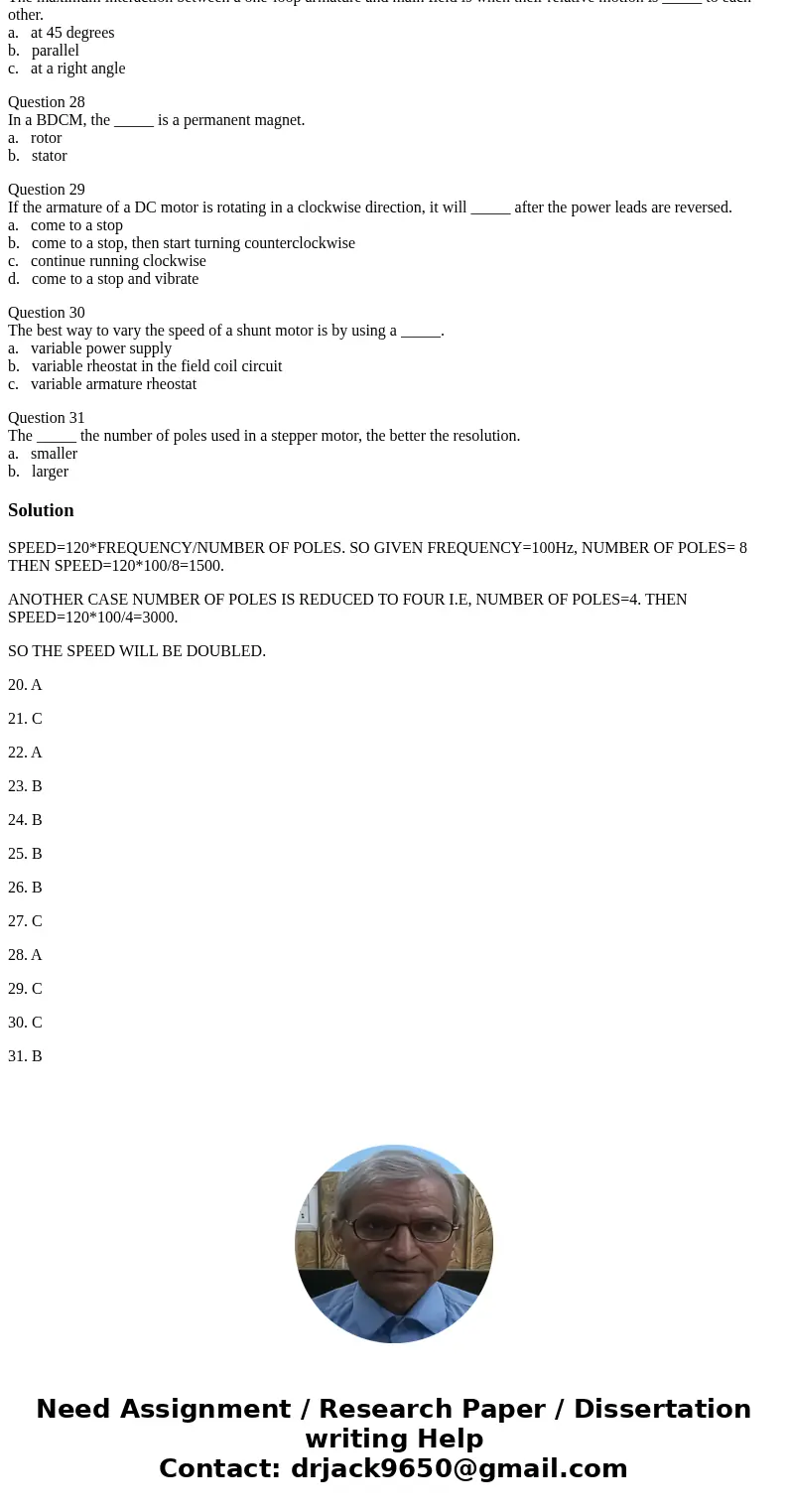SERVO MOTOR QUIZ Question 1 The direction of rotation of a D
SERVO MOTOR QUIZ
Question 1
The direction of rotation of a DC motor is changed by reversing the _____.
a. brush position
b. supply polarity
c. field and armature connections
d. field or armature connections
Question 2
Damper windings in a synchronous motor are used to _____.
a. reduce armature reaction
b. reduce overshoot when the motor stops
c. create a starting torque
d. provide good speed regulation
Question 3
If a split-phase motor hums and does not turn after power is applied, the most likely problem is _____.
a. a short exists
b. the start winding is open
c. the motor shaft is stuck
d. the motor is overloaded
Question 4
The rotor of the AC brushless servo motor has high-resistance conducting bars _____.
a. to reduce a build-up of CEMF
b. to prevent rotation when it is single-phased
c. to prevent overheating when the rotor is stationary
Question 5
The reason why a wound armature PM motor has linear speed-torque characteristics is because there is no EMF induced into the field poles to cause the field strength to vary.
a. True
b. False
Question 6
In a brushless DC motor (BDCM), the field _____.
a. is stationary
b. rotates
Question 7
To stop the rotor in an AC brushless servo motor, _____.
a. the main field is turned off
b. the output of the auxiliary winding drops to zero
c. the auxiliary and main windings pulsate together
d. the fields around both the main and auxiliary windings are both stationary and at their maximum value
Question 8
A universal motor operates like a _____ motor when DC power is supplied.
a. series
b. shunt
c. compound
Question 9
The shunt motor has _____ speed regulation.
a. poor
b. fair
c. good
Question 10
A synchronous motor does not have a good starting torque without _____.
a. amortisseur
b. a key
c. a spider
d. salient poles
Question 11
The direction of rotation by the shaft of a universal motor can be changed by reversing the AC power leads.
a. True
b. False
Question 12
The speed of an AC servo motor is controlled by the _____.
a. frequency of the AC supply
b. amplitude of the signal supplied to the main winding
c. amplitude of the signal supplied to the auxiliary winding
Question 13
Torque can be produced by a motor when its shaft is not turning.
a. True
b. False
Question 14
An AC brushless servo motor uses a _____ rotor.
a. permanent magnet
b. squirrel-cage
c. wire-wound
Question 15
Which of the following types of motors are capable of being stalled without being permanently damaged?
a. split-phase
b. capacitor-start
c. synchronous
d. wound rotor
e. universal
Question 16
The runaway condition is possible with a permanent magnet motor.
a. True
b. False
Question 17
The field strength in which the AC brushless servo motor winding is varied to control the speed or position of the rotor is _____.
a. auxiliary
b. main
c. both windings
d. none of the above
Question 18
A synchronous motor is categorized as an induction motor.
a. True
b. False
Question 19
100 Hz is applied to an eight-pole squirrel-cage motor. What happens to the synchronous speed if the number of poles are reduced to four?
a. It is half.
b. It doubles.
c. It is one-fourth.
d. It is four times greater.
Question 20
The term field pole is synonymous with the word stator.
a. True
b. False
Question 21
Which of the following conditions will cause a DC series motor to develop into a runaway condition?
a. the armature coil opens
b. the field coil opens
c. the physical load which it drives becomes disconnected
d. all of the above
Question 22
The primary reason for a DC series motor runaway condition is _____.
a. the armature current increases faster than the CEMF
b. the CEMF does not increase as fast as the motor speed
c. the CEMF increases faster than the motor speed
Question 23
When the DC excitation increases to cause an over-excited synchronous motor, a _____ is developed.
a. lagging power factor
b. leading power factor
c. unity power factor
d. none of the above
Question 24
The _____ is considered a constant speed motor.
a. DC series
b. DC shunt
c. DC compound
Question 25
To vary the speed of a moving coil motor (MCM), _____ is varied.
a. a DC voltage applied to the armature
b. the width of square wave pulses applied to the armature
c. the frequency of square wave pulses applied to the armature
Question 26
The capacitor-start AC motor has a capacitor in _____ with the _____ winding.
a. parallel, auxiliary
b. series, auxiliary
c. series, main
Question 27
The maximum interaction between a one-loop armature and main field is when their relative motion is _____ to each other.
a. at 45 degrees
b. parallel
c. at a right angle
Question 28
In a BDCM, the _____ is a permanent magnet.
a. rotor
b. stator
Question 29
If the armature of a DC motor is rotating in a clockwise direction, it will _____ after the power leads are reversed.
a. come to a stop
b. come to a stop, then start turning counterclockwise
c. continue running clockwise
d. come to a stop and vibrate
Question 30
The best way to vary the speed of a shunt motor is by using a _____.
a. variable power supply
b. variable rheostat in the field coil circuit
c. variable armature rheostat
Question 31
The _____ the number of poles used in a stepper motor, the better the resolution.
a. smaller
b. larger
Solution
SPEED=120*FREQUENCY/NUMBER OF POLES. SO GIVEN FREQUENCY=100Hz, NUMBER OF POLES= 8 THEN SPEED=120*100/8=1500.
ANOTHER CASE NUMBER OF POLES IS REDUCED TO FOUR I.E, NUMBER OF POLES=4. THEN SPEED=120*100/4=3000.
SO THE SPEED WILL BE DOUBLED.
20. A
21. C
22. A
23. B
24. B
25. B
26. B
27. C
28. A
29. C
30. C
31. B




 Homework Sourse
Homework Sourse